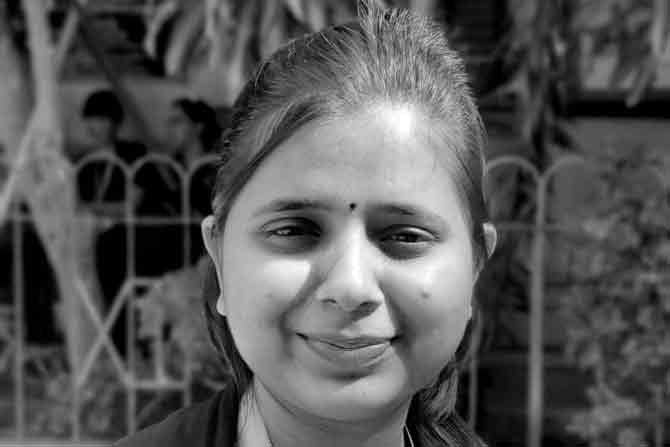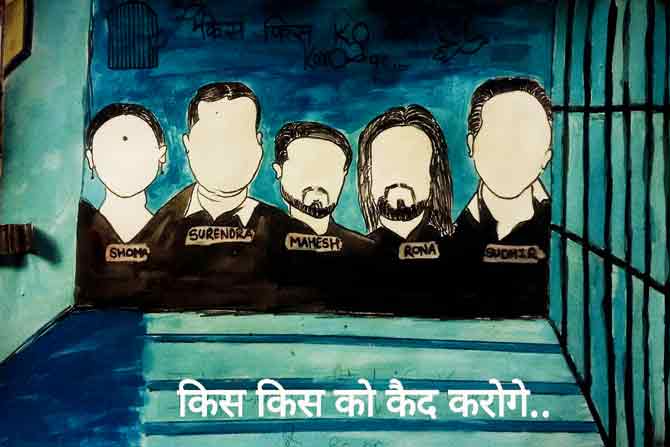An alumnus of St Xavier-s College, and member of a weaving community from Bihar-s Patwatoli, is amplifying the voice of Dalits with her new Anti-Caste Art Project

Shraddha Mores series of eight medium-acrylics on canvas, titled Bhook. More is a graduate of Sir JJ School of Art, Mumbai, and is doing her a post graduate diploma course in Ambedkar Thoughts from the University of Mumbai. Her series imagines food on the
Had it not been for the pandemic, Rimjhim Kumari would have been at St Catherine-s College in Oxford, UK, studying elective subjects—behavioural science and women in the modern world—as part of a scholarship programme. But the 20-year-old Economics graduate from St Xavier-s College, Mumbai, has little remorse. Back in her hometown Patwatoli, a tiny village in Manpur in Bihar-s Gaya district, Kumari is keeping herself busy with a unique project.
ADVERTISEMENT

Rimjhim Kumari
Since September 7, Kumari has been researching and engaging with Dalit artists across the country for her Anti-Caste Art initiative, which she undertook after being awarded the One Future Fellowship. The project explores and showcases the phenomenal body of work being churned out by Dalit artists, many of whom, she feels, continue to remain underappreciated despite being humdingers in their field. Kumari, who has collaborated with Dalit Camera, a YouTube Channel that documents perspectives on/voices of Dalits, Adivasis, Bahujans and Minorities DABM, has reached out to nearly 18 artists until now.
The initiative, says Kumari, stemmed from the desire that her own community, Patwa, categorised under the backward castes, gets its due. "We are a traditional weaving community that has been engaged in the trade for several generations. I have grown up watching my father spend hours at the loom, weaving cotton into gamchaas [towels], bedsheets and sarees," she says in a telephonic interview. "In fact, I used to help out at the loom, as a child. Most of us start learning to weave at a very early age. This is our bread and butter." Each piece of cloth—from dying to drying and then weaving on the loom—takes around two to three days, says Kumari, currently pursuing a masters from Mount Carmel College, Bengaluru.

Shraddha More
Despite the labour-intensive work, the community has received neither remuneration nor acknowledgment. "I have seen my family toil day and night, yet half of our products lie unsold in the godown. For several years, we have been selling our weaves to tribal communities in Assam and West Bengal. But the community hasn-t explored opportunities beyond. They have no knowledge about the value of their work, in the outside world. If there is a change in government policy, we are not aware of that either," says Kumari. The shoddy treatment towards craftsmen and artisans, who are the real faces behind the country-s handlooms and handicrafts, compelled her to research her community for a college project at St Xavier-s. She was able to broaden the scope of her work after she received the fellowship from One Future Collective, a feminist youth-led not-for-profit organisation that works on building compassionate youth social leadership in India.
Until before working on the Anti-Caste Art project, Kumari hadn-t heard about many of these artists. "They rarely enjoy the kind of limelight or space that members of upper caste communities do," she explains. She had to start from scratch for this one. "Instagram helped me make some headway. I connected with a few Dalit artists there, who led me to the rest," she says. Apart from profiling them and their motivation to pursue art, she also sourced some of their best artworks, which were later shared on the Dalit Camera-s Twitter handle.

Ramabai Bhimrao Ambedkar by Ajinkya Dekhane
Some of the artists featured include Shraddha More, Alaka Aditi, Somnath Waghmare, Azinzya, Raam Jator, Priyanka Patil and Amit Kshirsagar. The work that stood out for Kumari, though, was More-s series of eight medium-acrylics on canvas, titled Bhook. More is a graduate of Sir JJ School of Art, Mumbai, and is doing a post graduate diploma course in Ambedkar Thoughts from University of Mumbai. Her series imagines food on the plate of a Dalit—fried fish accompanied with plain rice, raw onions and lemon—and how it-s relished, before the plate is swiped clean of every grain and flesh. "Each day, earning food is at the heart of the Dalit Bahujan-s struggle.
Perhaps the most significant way oppression is felt is through hunger. A day without food is hell and a day with food, heaven. For Dalit Bahujan, good food means meat and fish. We relish it. For Brahmins, Baniyas even, discussion about meat and fish is nauseating," More says about her art work, adding, "These differences are not the differences of individual taste, they are differences created as part of our upbringing which one internalises due to centuries of discrimination. Eating and food choices are political. In India, your food choice isn-t purely personal; it-s determined by caste and community. Caste made the subaltern eat what they did. This creates cultural hierarchy where certain foods are deemed inferior and sometimes non-Indian." The reality of this artwork, says Kumari, tugged at her heartstrings.

Kis Kis Ko Qayd Karoge by Samiksha Bamne
Vandita Morarka, founder and CEO of One Future Collective, feels that Kumari-s is a "powerful voice". "I-m glad the fellowship gave her the nudge to share that voice with the world. Anti-Caste Art is truly reflective of and grounded in community values. It brings visibility and attention to art that has the power to transform people and communities."

Why So Much Hate by Raam Jator
Kumari is planning to continue with the project, and has even approached the Dalit Foundation to support it. "Since I belong to a backward caste myself, I am aware of the hardships we face. When I lived in Mumbai for three years, every day was a struggle, financially and emotionally. It was a different life, from the one I had lived in Patwatoli. Fortunately, my college principal [at St Xavier-s] was very kind—he waived off the fees, and ensured that I got free food at the canteen." This kindness, she says, needs to reflect across humanity.
Keep scrolling to read more news
Catch up on all the latest Mumbai news, crime news, current affairs, and a complete guide from food to things to do and events across Mumbai. Also download the new mid-day Android and iOS apps to get latest updates.
Mid-Day is now on Telegram. Click here to join our channel @middayinfomedialtd and stay updated with the latest news
 Subscribe today by clicking the link and stay updated with the latest news!" Click here!
Subscribe today by clicking the link and stay updated with the latest news!" Click here!






